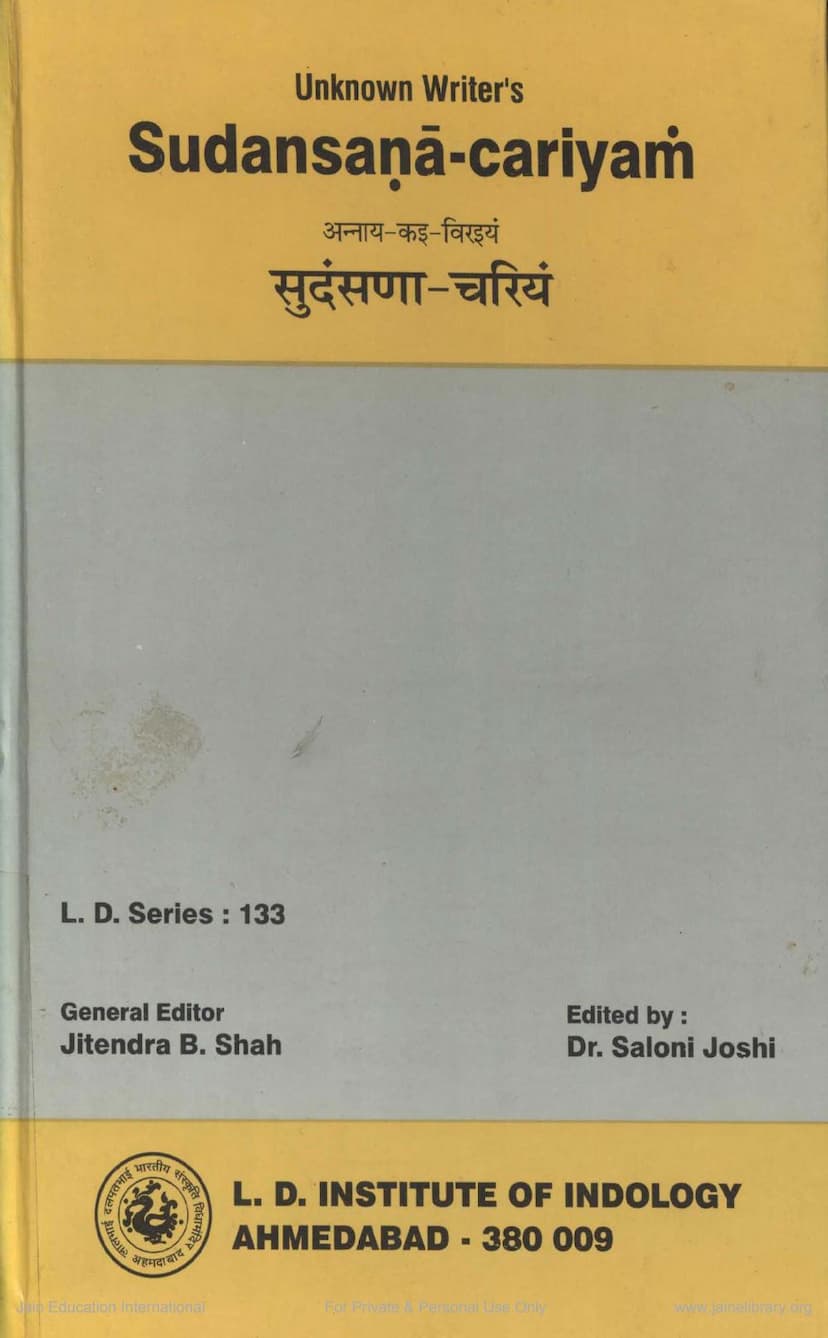Sudansana Cariyam
Added to library: September 2, 2025
Loading image...

Summary
The provided text is a comprehensive scholarly edition of the Jain text "Sudansana Cariyam" (सुदंसणा-चरियं) by an unknown author. The edition is compiled and edited by Dr. Saloni Joshi and published by the L. D. Institute of Indology in Ahmedabad.
Here's a summary of the key information and content presented in the text:
Book Details:
- Title: Sudansana Cariyam (सुदंसणा-चरियं)
- Author: Unknown Writer (अन्नाय-कइ-विरइयं)
- Publisher: L. D. Institute of Indology, Ahmedabad
- Series: L. D. Series : 133
- General Editor: Jitendra B. Shah
- Editor: Dr. Saloni Joshi
- First Edition: November, 2002
- ISBN: 81-85857-15-6
- Language: Prakrit
Textual and Scholarly Aspects:
- Manuscript: The text is based on a sole palm-leaf manuscript found in the Shantimath Jain Gyanbhandar in Khambhat. The manuscript has 232 (+5) leaves, with the first leaf being fragmentary and the final praise leaf destroyed. The manuscript dates back to the 13th century Vikram Samvat.
- Editorial Process: Dr. Saloni Joshi undertook the challenging task of editing the text based on this single, often fragmented, manuscript. The introduction highlights the difficulties faced due to incomplete verses and scribal errors. The editor meticulously noted these issues and provided textual corrections.
- Structure: The text is divided into 12 Uddeshas (chapters) and contains approximately 1600 gathas (verses).
Content and Themes:
- Purpose: The primary purpose of the work is to establish the significance of the Jain pilgrimage site of Ashavabodhan (अश्यावबोधा) and the Shankunika Vihara (शकुनिकंव्याहार) in Bharuch. It also aims to impart religious teachings and inspire renunciation.
- Narrative Framework: The story begins with Dhanpal, who narrates the life story of Sudarshana to his beloved. This central narrative encompasses Sudarshana's previous births and her journey towards spiritual enlightenment. The story is further enriched by the embedded tales of Shilavati and Vijaykumar.
- Key Characters:
- Sudarshana (सुदर्शना): The central protagonist, whose life story, including her previous births, is central to the narrative. This edition includes a detailed synopsis of the story, highlighting the narrative structure and the connections between different characters and events.
- Literary and Cultural Value:
- Social and Religious Insights: The descriptions of nature, cities, customs, and individual characters offer valuable insights into the social and religious life of the period.
- Literary Style: The author employs a simple and elegant style, rich with descriptions, similes, and metaphors, contributing to the didactic and devotional tone of the work.
- Religious Teachings: The text extensively covers Jain principles such as non-violence (ahimsa), renunciation, devotion to the Jinas, the importance of knowledge, conduct, and penance, the nature of karma, and the path to liberation.
- Geographical and Historical References: The work mentions significant places like Bharuch (Bhrgukachha), Singhaladvipa, and Vimalshaila, providing geographical context. It also implicitly refers to the political and social milieu of its time.
- Comparison with Other Works: The introduction discusses other Jain texts related to the Sudarshana legend, notably the "Sudarsana Charitra" by Devendrasuri, highlighting similarities and differences in their narratives and scope.
- Language: The text is in Jain Maharastrian Prakrit, with influences from Apabhramsha and contemporary spoken language. It also contains a rich vocabulary of specific Jain technical terms and many local Gujarati words.
- Meter: The primary meter used is the gatha (gaha), with occasional use of Sanskrit meters and Apabhramsha verses.
- Analysis of Content: The editorial work includes a detailed analysis of the narrative construction, the use of literary devices (alankars), the language, the religious doctrines expounded, and the cultural details presented, making it a valuable resource for scholars and students of Jain literature and history.
- Tirth Significance: A significant portion of the introduction and the text itself is dedicated to the history and legends associated with the Ashavabodhan tirth and Shankunika Vihara in Bharuch, including details of their construction and renovation.
In essence, this edition of "Sudansana Cariyam" provides a critical study and a complete Gujarati translation of a significant but lesser-known Prakrit Jain narrative poem. It is a testament to the rich tradition of Jain literature and its role in preserving religious teachings, historical anecdotes, and cultural insights.